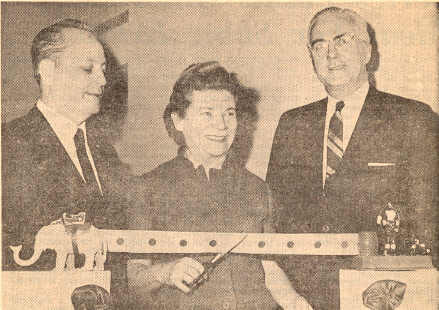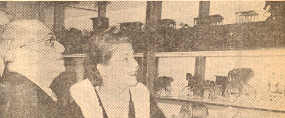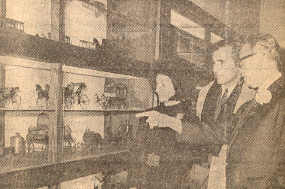COIN WORLD, Wednesday, February 19, 1969
Toy Museum Features 'Penny Banks'
Director of the U.S. Mint Eva Adams is about to cut the "Indian Head Cents"
ribbon at the opening of the Perelman Museum in Philadelphia. The cents
represent the period coin used to activate two mechanical banks shown on
pedestals, namely the "Jumbo Elephant" and "Trick Dog" banks. Leon J.
Perelman, left, owns the museum; James A Tate, Philadelphia mayor watches.
The new Perelman Antique Toy Museum, 270 South Second street, Philadelphia, Pa., contains the largest and finest collection of mechanical "penny banks" and antique toys in the United States, according to museum officials. The museum is a member of the American Association of Museums.
Owner-director Leon J. Perelman, a partner in the American Paper Products Co., Philadelphia, started his collection of American antique toys and mechanical savings banks in the mid-1950's. He is past president of the Mechanical Bank Collectors of America and president-elect of the Antique Toy Collectors of America.
Featuring a toy panorama of mid-nineteenth century Americana, the new museum exhibits approximately 1000 mechanical animated and still toys and banks of cast iron or tin, covering the period from about the end of the Civil War to the beginning of World War I. Toys are systematically arranged and represent the survivors of many thousands of their kind that were made nearly a hundred years ago.
Probably no group of antique toys has attracted so much attention as the "mechanical banks" which are so eagerly sought after by collectors today and were first patented in 1865. In 1867, the first bank appeared and their popularity ran until 1902. The span of life for the manufacture of mechanical banks was about 35 years. Of the 243 known types of mechanical banks, 225 different kinds are shown in the Perelman Museum. Each bank, most of them constructed of cast iron, performs a unique mechanical action or stunt.
Mechanical banks provided a pleasant way of saving money a few generations back. The coin receptacles were originally created to lure children into the habit of thrift by their curiosity to see the bank work. It was a sugar-coated method of saving that appealed not only to children, but also to the parents who purchased these banks in large quantities. A coin inserted in the slot of any of these banks produces clever, amusing and sometimes noisy results.
For instance, the William Tell bank uses a real cap, which explodes noisly when William Tell fires a cent at an apple on his son's head.
Jonah and the Whale bank - Jonah, safe in a little boat, feeds the coin, instead of himself, to the whale.
Uncle Sam bank - Uncle Sam nods his head as if to say "thank you" when coin placed in his outstretched hand slips into his carpet bag.
Each bank performs a mechanical action or stunt before it deposits the coin within itself for safekeeping. A coin is placed on the elephant's snout and by twisting the tail the snout flips the coin in the air and it lands in a slot in the elephant's back. A magician causes a coin to disappear into the bank by merely lowering and raising his hat on the coin. The mechanical toy bank is truly a peculiarly American phenomenon.
The museum also exhibits a wide assortment of Automatona toys, each of which entertains with one or more mechanical actions; for instance, U.S. Grant, seated in chair, smokes with satisfaction, turning his head and puffing out smoke leisurely; a preacher at his pulpit exhorts his flock; a minstrel man swings musical clappers in his hands.
There is also a rare collection of animated cap pistols ingenious contrivances with fantastically shaped and decorated handles and with figures of men or animals mounted on the barrel. When the trigger is pulled the figures kick, buck, bite or otherwise react in such a way as to explode the cap through their violent motions.
Equally as scarce and desirable as these animated cap pistols are the cast iron toys in the Perelman Museum. Fire engines, hook and ladders, stage coaches, hansom cabs, brakes, gigs and other types of vehicles are on display to tell the toy history of our nation.
Philadelphia's Perelman Antique Toy Museum is a unique and different kind of museum that presents a rare and fascinating bit of Americana.
The museum is located in the historic Abercrombie House, built shortly after the site was purchased by James Abercrombie, Sr., a noted Colonial seaman, in 1758. The four-story brick house, one of only two of its kind in that section of Philadelphia, has been completely restored by Perelman.
The new Society Hill Museum is open to the public 9:30 a.m. to 5 p.m., Monday through Saturday. General admission cost is adults - $1. Children under 14 and servicemen - $.55. Group rates for 25 or more are adults - $.75; teenagers - $.55, and children - $.40, with one leader admitted free with each group.
Eva Adams, director of the U.S. Mint, points out an
interesting detail on an antique toy to Max Liberman,
well known numismatist and former assay commissioner,
at the opening of the Perelman Museum.
Bud Barol, right, acting public relations director
for the Perelman Museum, is describing the mechanics
of an antique fire engine to Al Nipon and his wife, Nipon
and Barol are members of the Philadelphia Coin Club.



